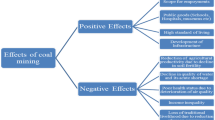Abstract
In this study, by carrying on the spot investigation to the seven coal cities in Northeast China and interviewing with the local authority and the residents, the authors definite the vulnerability that is closed to exposure, sensitivity and resilience, and set up vulnerability model of coal cities in Northeast China. At the same time, the authors broadly illustrate how the components of natural-social-economic system act in the coal area, so as to probe the ways to reduce vulnerability more effectively, such as preferential national policy and so on. Furthermore, the article studies the relationship between vulnerability and sustainable development. Vulnerability is a spatio-temporal function of sustainable development. The regional sustainable development refrains the spiral ascending of vulnerability. And the regional vulnerability and sustainable development appear in turn. Then the article analyzes the natural vulnerability, social vulnerability and economic vulnerability of coal cities in Northeast China. At last, combing vulnerability model and situation of coal cities in Northeast China, the authors put forward regional technology innovation mode, multi-dimension structure transformation mode, attracting investment mode and recycling economy mode to reduce vulnerability.
Similar content being viewed by others
References
Adger W N, 2006. Vulnerability. Global Environmental Change, 16(3): 268–281. DOI: 10.1016/j.gloenvcha.2006. 02.006
Bao Chao, Fang Chuanglin, 2006. Strategic thoughts and patterns on the sustainable exploitation and utilization of natural resources for mining cities in China learning from the experience of cities of Dongying, Jiaozuo and Karamy. Journal of Natural Resource, 21(6): 900–909. (in Chinese). DOI: cnki: ISSN: 1000-3037.0.2006-06-006
Brooke C, 2002. Climate change, vulnerability and conservation in CostaRica: An investigation of impacts, adaptive environmental management and national adaptation networks. Oxford, UK: School of Geography and the Environment, University of Oxford.
Brooks N, Adger W N, Kelly M K, 2005. The determinants of vulnerability and adaptive capacity at the national level and the implications for adaptation. Global Environmental Change, 15(2): 151–163. DOI: 10.1016/j.gloenvcha.2004.12.006
Downing T E, Butterfield R, Cohen S, 2001. Climate change vulnerability: linking impacts and adaptation. Report to the Governing Council of the United Nations Programme. Nairobi, Kenya: United Nations Environmental Programme.
Gallopin G C, 2006. Linkages between vulnerability, resilience, and adaptive capacity. Global Environmental Change, 16: 292–303. DOI: 10.1016/j.gloenvcha.2006.02.004
Han Liang, Li Bo, Song Tao et al., 2006. Circular-economy models of animal husbandry industry in Jilin Province. Chinese Geographical Science, 16(2): 148–153. DOI: 10.1007/s11769-006-0009-2
Lu Dadao, 2005. Some advices about Northeast promotion and sustainable development. Northern Economy, 22(4): 5–11. (in Chinese)
McCarthy J J, Canziani O F, Leary N A et al., 2001. Climate Change 2001: Impacts, Adaptation and Vulnerability. Cambridge: Cambridge University Press, 244–277.
Moss R H, Brenkert A L, Malone E L, 2001. Vulnerability to Climate Change: A Quantitative Approach. Technical Report PNNL-SA-33642, Richland, WA: Pacific Northwest National Laboratories.
National Bureau of Statistics of China, 2003. China Industry Economy Statistical Yearbook 2003. Beijing: China Statistics Press. (in Chinese)
O’Brien K, Eriksen S, Schjolen A, 2004. What’s in a word? Conflicting interpretations of vulnerability in climate change research. CICERO Working Paper. Blindern: Oslo University, 144–158.
Seitz S, 1998. Coping strategies in an ethnic minority group: The area of Mount Pinatubo. Disasters, 22(1): 76–90. DOI: 10.1111/1467-7717.00076
Statistical Bureau of Heilongjiang Province, 2006. Heilongjiang Statistical Yearbook 2005. Beijing: China Statistics Press. (in Chinese)
Statistical Bureau of Jilin Province, 2006. Jilin Statistical Yearbook 2005. Beijing: China Statistics Press. (in Chinese)
Statistical Bureau of Liaoning Province, 2006. Liaoning Statistical Yearbook 2005. Beijing: China Statistics Press. (in Chinese)
Timmermann P, 1981. Vulnerability, Resilience and the Collapse of Society. Toronto, Canada: Institute for Environmental Studies, University of Toronto.
Wang Hong, Wang Jun, Zhong Weiqing, 2004. Study of social security fund problems in Fuxin in 2000. Journal of Liaoning Technical University (Social Science Edition), 6(2): 144–146. (in Chinese)
Wang Xugao, Li Xiuzhen, He Hong et al., 2004. Ecological restoration: Our hope for the future? Chinese Geographical Science, 14(4): 361–367. DOI: 10.1007/s11769-004-0042-y
Westgate K N, O’Keefe P, 1976. Some Definitions of Disaster. Canada: Department of Geography, University of Bradford.
Wu Yin, 2005. Thingking about the healthy development in coal industry. Mine Economy Research, 28(5): 4–6. (in Chinese)
Yu Junbao, Liu Jingshuang, Wang Jinda et al., 2002. Spatial-temporal variation of heavy metal elements content in covering soil of reclamation area in Fushun coal mine. Chinese Geographical Science, 12(3): 268–272. DOI: 10.1007/s11769-002-0013-0
Author information
Authors and Affiliations
Corresponding author
Additional information
Foundation item: Under the auspices of Key Program of National Science Foundation of China (No. 40635030), National Natural Science Foundation of China (No. 40571041)
Rights and permissions
About this article
Cite this article
Bo, L., Lianjun, T. Vulnerability and sustainable development mode of coal cities in Northeast China. Chin. Geogr. Sci. 18, 119–126 (2008). https://doi.org/10.1007/s11769-008-0119-0
Received:
Accepted:
Published:
Issue Date:
DOI: https://doi.org/10.1007/s11769-008-0119-0




